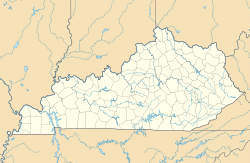Audubon Park, Kentucky
| Audubon Park, Kentucky | |
|---|---|
| City | |

Entrance pillars to Audubon Park
|
|
| Location within the state of Kentucky | |
| Coordinates: 38°12′18″N 85°43′39″W / 38.20500°N 85.72750°WCoordinates: 38°12′18″N 85°43′39″W / 38.20500°N 85.72750°W | |
| Country | United States |
| State | Kentucky |
| County | Jefferson |
| Area | |
| • Total | 0.3 sq mi (0.8 km2) |
| • Land | 0.3 sq mi (0.8 km2) |
| • Water | 0.0 sq mi (0.0 km2) |
| Elevation | 512 ft (156 m) |
| Population (2000) | |
| • Total | 1,545 |
| • Density | 4,788.6/sq mi (1,848.9/km2) |
| Time zone | Eastern (EST) (UTC-5) |
| • Summer (DST) | EDT (UTC-4) |
| FIPS code | 21-02656 |
| GNIS feature ID | 0486138 |
|
Audubon Park Historic District
|
|
| Location | Roughly bounded by Hess Ln. and Cardinal Dr. between Eagle Pss and Preston St., Audubon Park, Kentucky |
| Area | 230 acres (93 ha) |
| Built | 1912 |
| Architectural style | Tudor Revival, Colonial Revival, Bungalow/craftsman |
| MPS | Louisville and Jefferson County MPS |
| NRHP Reference # | 96000430 |
| Added to NRHP | April 18, 1996 |
Audubon Park is a home rule-class city in central Jefferson County, Kentucky, United States. The population was 1,545 at the 2000 census. It is located about 3 miles (4.8 km) south of Downtown Louisville and is surrounded on all sides by the city of Louisville.
Audubon Park was developed residentially in the early 20th century on 230 acres (0.93 km2) of hilly pastureland once owned by Gen. William Preston, who in turn had been granted the land in 1774 from the British government as payment for his services during the French and Indian War.
The land was sold to G. Robert Hunt in 1906, and the Audubon Park Country Club was built by avid golfer Russell Houston. The Audubon Park Realty Co. purchased the land in 1912 and named the neighborhood after wildlife painter John James Audubon. All but two of the city's 20 streets are named after birds.
Development was very slow until Louisville Gas and Electric laid gas mains and installed streetlights in the 1920s, at which point it was estimated that a new house was begun every two weeks. Most houses are traditional in design, with styles including Neo-Colonial, Dutch colonial and Neo-federal, though some Craftsman-style California Bungalows are present.
An early streetcar spur route ran to a station house near the center of the park (the station house has been converted to a private residence and still stands). The line was discontinued in the 1920s, although the tracks were not entirely removed until 1975. The city was formally incorporated by the state assembly in 1941.
...
Wikipedia


